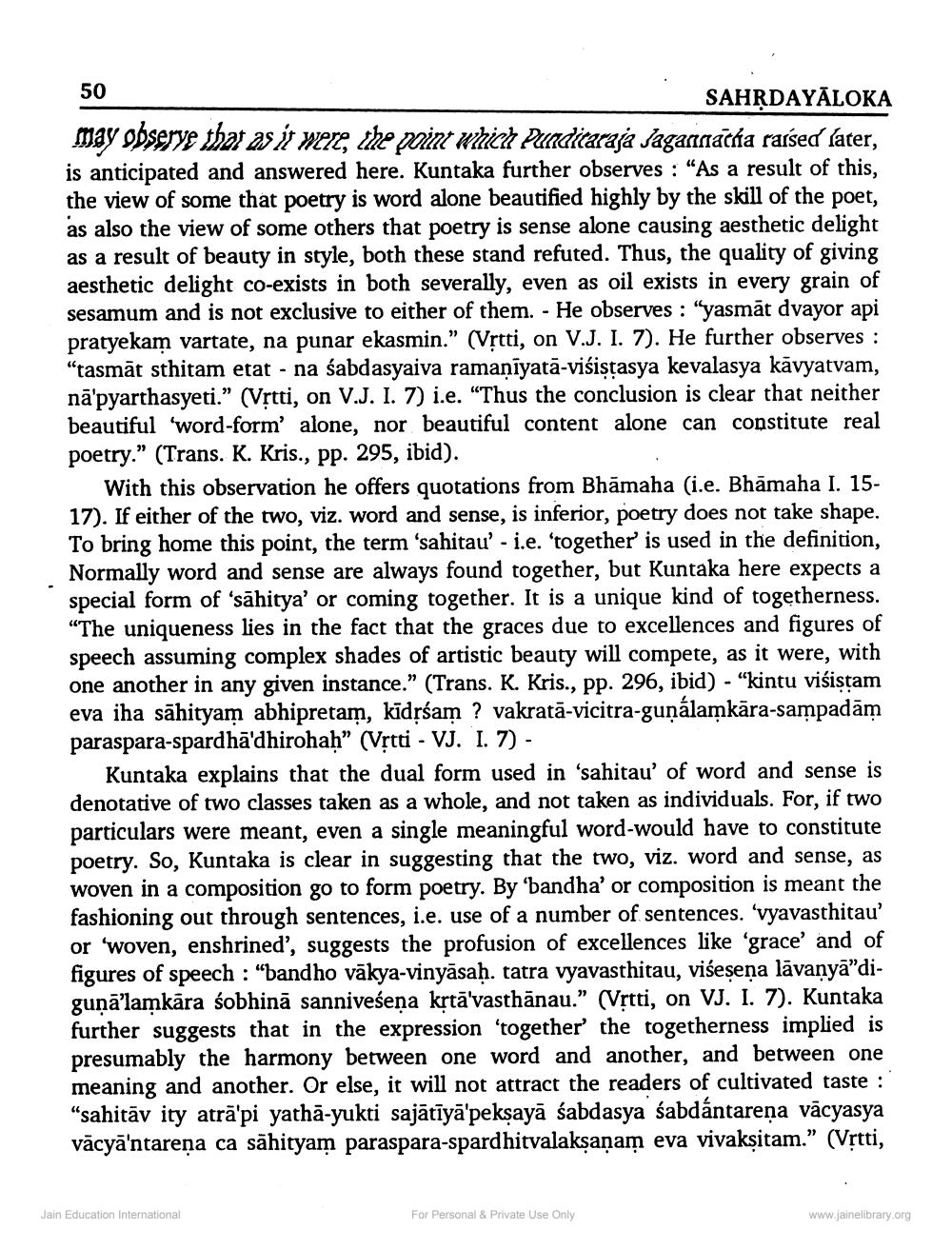________________
50
SAHRDAYALOKA
may observe that as it were, the point which Punditaraja Jagannacha raised later, is anticipated and answered here. Kuntaka further observes: "As a result of this, the view of some that poetry is word alone beautified highly by the skill of the poet, as also the view of some others that poetry is sense alone causing aesthetic delight as a result of beauty in style, both these stand refuted. Thus, the quality of giving aesthetic delight co-exists in both severally, even as oil exists in every grain of sesamum and is not exclusive to either of them. He observes: "yasmāt dvayor api pratyekam vartate, na punar ekasmin." (Vṛtti, on V.J. I. 7). He further observes : "tasmāt sthitam etat - na śabdasyaiva ramaṇīyata-visiṣṭasya kevalasya kavyatvam, na'pyarthasyeti." (Vṛtti, on V.J. I. 7) i.e. "Thus the conclusion is clear that neither beautiful 'word-form' alone, nor beautiful content alone can constitute real poetry." (Trans. K. Kris., pp. 295, ibid).
With this observation he offers quotations from Bhamaha (i.e. Bhamaha I. 1517). If either of the two, viz. word and sense, is inferior, poetry does not take shape. To bring home this point, the term 'sahitau' - i.e. 'together' is used in the definition, Normally word and sense are always found together, but Kuntaka here expects a special form of 'sahitya' or coming together. It is a unique kind of togetherness. "The uniqueness lies in the fact that the graces due to excellences and figures of speech assuming complex shades of artistic beauty will compete, as it were, with one another in any given instance." (Trans. K. Kris., pp. 296, ibid) - "kintu viśistam eva iha sahityam abhipretam, kīdṛśam ? vakrata-vicitra-gunálamkara-sampadām paraspara-spardha'dhirohaḥ" (Vṛtti - VJ. I. 7) -
Kuntaka explains that the dual form used in 'sahitau' of word and sense is denotative of two classes taken as a whole, and not taken as individuals. For, if two particulars were meant, even a single meaningful word-would have to constitute poetry. So, Kuntaka is clear in suggesting that the two, viz. word and sense, as woven in a composition go to form poetry. By 'bandha' or composition is meant the fashioning out through sentences, i.e. use of a number of sentences. 'vyavasthitau' or 'woven, enshrined', suggests the profusion of excellences like 'grace' and of figures of speech: "bandho vākya-vinyāsaḥ. tatra vyavasthitau, viseṣena lavanya"diguṇā'lamkāra śobhina sanniveśeņa kṛtā'vasthānau." (Vṛtti, on VJ. I. 7). Kuntaka further suggests that in the expression 'together' the togetherness implied is presumably the harmony between one word and another, and between one meaning and another. Or else, it will not attract the readers of cultivated taste : "sahitāv ity atra'pi yatha-yukti sajātīyā'pekṣayā sabdasya sabdántareņa vācyasya vacyā'ntareṇa ca sahityam paraspara-spardhitvalakṣaṇam eva vivakṣitam." (Vṛtti,
Jain Education International
For Personal & Private Use Only
www.jainelibrary.org




